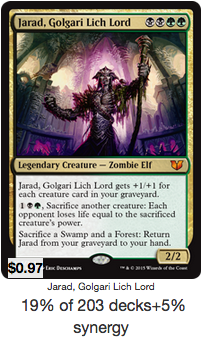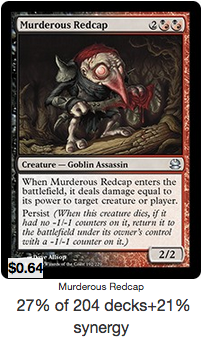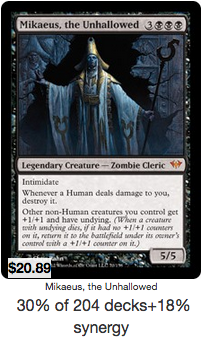This article is Round 4 of the Underdog’s Corner, a series spotlighting various lesser-used commanders and their place in the format. Each article makes the argument for a single commander that deserves more play, as well as highlighting key cards and synergies.
The bell has rung, and we're back in the ring with this installment of the Underdog's Corner! One thing I noticed after the first three articles is that all the commanders so far contained blue. To those who don't know me personally, blue actually isn't my favorite color. I'm sorry to have misled you with my articles' bias. Along with this change, our newest underdog is going to explore a color yet to be seen in the series: black. Ladies and gentlemen, with a face only a mother could love, meet Sek'Kuar, DeathkeeperSek'Kuar, Deathkeeper! Coming in as only the 5th most played Jund commander, our red, green, and black Orc Shaman was probably beginning to think he was permanently left out in the cold.
Sek'Kuar, Deathkeeper
First appearing in Coldsnap and then again in Commander 2013, Sek'kuar has always competed with other more obviously powerful commanders. In Coldsnap, our orc general had to compete with the likes of Zur the EnchanterZur the Enchanter, Arcum DagssonArcum Dagsson, and even Darien, King of KjeldorDarien, King of Kjeldor. Then, when he was reprinted he had to stand against Prossh, Skyraider of KherProssh, Skyraider of Kher. Looking at those legends, it's easy to see how he struggled in his own weight class.
I personally didn't really give Sek'kuar a hard look until recently. That's not his fault; most Jund commanders haven't interested me. When I started re-reading his card lately, the wheels started turning in my mind. How can we use this guy to full potential? What am I missing?
At first glance, there are a couple of limitations that stuck out to me that hindered my outlook.
"Whenever another nontoken creature you control dies..."
This line is what has always discouraged me quickly from giving Sek'Kuar a closer look. I love creature tokens as a general rule, and seeing text that reads "nontoken" throws up a caution sign for me. Along with that, Sek'Kuar specifies that another creature has to die to get a Graveborn token, which means that our general won't replace himself with a token. I guess everything can't work out how we want it.
As I started brewing, I couldn't get over his limitations. Every obvious option quickly got nixed because the interaction either produced a creature token, or the recursion element was anti-synergistic, such as Unearth. However, the more I dug into Sek'Kuar, the more possibilities I found, and I began to get more and more excited about his potential.
A Nontoken Affair


As we noted earlier, Sek'Kuar's ability specifically requires that nontoken creatures die. This can take us in two different directions. The first and most obvious is looking at other cards that benefit from nontoken creatures dying. If our deck list is geared towards taking advantage of nontoken creatures from the beginning, we can start to include other cards without making sacrifices... yet. While there are not that many cards that benefit from having nontoken creatures die, we do get redundancy in the effects.
Grim HaruspexGrim Haruspex and Harvester of SoulsHarvester of Souls both give us draw power to go with our creatures dying. According to EDHREC, each of these creatures appear in about 40% of Sek'Kuar decks. Sifter of SkullsSifter of Skulls and Pawn of UlamogPawn of Ulamog can stay on the board and allow us to replace our creatures when they die, while Caller of the ClawCaller of the Claw and Vile RedeemerVile Redeemer can be held in hand to allow us to replace our creatures with bear tokens and eldrazi scions respectively when required. One interesting thing to note is that Sifter of SkullsSifter of Skulls and Pawn of UlamogPawn of Ulamog both appear in Sek'Kuar's signature cards, while Caller of the ClawCaller of the Claw and Vile RedeemerVile Redeemer don't appear on the page at all.
Another card that doesn't appear on Sek'Kuar's EDHREC page is Whisperwood ElementalWhisperwood Elemental. It's a card that I've always really liked, but I had never found a deck for it until now. Not only does Whisperwood replace each of our dying creatures, but each manifested replacement also counts as a nontoken creature as well, allowing Sek'Kuar to create more Graveborn tokens if need be.
The Usual Suspects and Friends


To no one's surprise, a deck headed by a commander who cares about creatures dying should include ways to sacrifice creatures. Free sacrifice outlets are incredibly important, and because of that fact, we will often see the same cards fill that role. Both Evolutionary LeapEvolutionary Leap and Birthing PodBirthing Pod are very common sac-outlets for good reason. Assuming that we have Sek'Kuar on the board, Evolutionary Leap allows us to draw two creature cards for two green mana for each nontoken creature, which is great. Ashnod's AltarAshnod's Altar, while also a common sight, plays a synergistic role in the deck that will be discussed later on. However, for this deck we might want to consider leaning towards using more creature-based sac-outlets, such as Viscera SeerViscera Seer and Carrion FeederCarrion Feeder.

While those cards allow us to sacrifice for free, I think it's a mistake to overlook others entirely. Korozda GuildmageKorozda Guildmage has the "nontoken" clause that been prevalent so far, allowing us to creature a mass of tokens. Qarsi High PriestQarsi High Priest may be an unknown to some players, but I think it offers a very interesting effect. While it does need to tap to sacrifice a creature, the priest allows us to turn tokens into nontoken creatures, which is a unique angle to this humble one-drop. Jarad, Golgari Lich LordJarad, Golgari Lich Lord is probably one of my favorite sac-outlets available as he lets us hit each of our opponent's hard at the cost of a creature. Jarad, while being incredibly potent himself, is also my way of foreshadowing where this deck idea is going to go.
An Undying Devotion
"Karplusan legend told of an orc so cruel that he burned his own followers in rage - yet so revered that they rose from their pyres to serve him."
Just like Sek'Kuar's flavor text from Coldsnap suggests, we're looking for creatures that double as sacrificial lambs. You probably noticed, but I really like the interaction between Sek'Kuar and manifest. Sultai EmissarySultai Emissary gives us access to two bodies to sacrifice for Graveborn tokens for a very low cost. Yavimaya ElderYavimaya Elder and Sakura-Tribe ElderSakura-Tribe Elder both function as great ways to ramp ourselves while also trading up in stats.
We can also make card choices based on taking advantage of our focus on creatures dying. For example using Caustic CaterpillarCaustic Caterpillar and Viridian ZealotViridian Zealot may be preferred over using Reclamation SageReclamation Sage and Acidic SlimeAcidic Slime if we're looking for artifact and enchantment destruction.
Sharing is caring, right? If we're going to make card choices based on creature's getting value from sacrificing themselves, why not consider Grave PactGrave Pact and Dictate of ErebosDictate of Erebos to share that with our opponents? If our opponent's are running very few creatures, we should be able to clear their boards while slowly amassing a steady stream of Graveborn tokens as well.
At this point we're throwing creatures into the graveyard fairly often, but how do we take advantage of this?
While Meren of Clan Nel TothMeren of Clan Nel Toth on her own is far and away the most popular green-black commander, she is also a perfect inclusion to this deck. With Sek'Kuar specifically, Meren gets two experience counters for each nontoken creature that is killed under our control, and we get to bring back that creature over and over. Even on her own, she'll function as a Raise DeadRaise Dead effect at worse.
Kessig CagebreakersKessig Cagebreakers, Spider SpawningSpider Spawning, Svogthos, the Restless TombSvogthos, the Restless Tomb, and the previously mentioned Jarad, Golgari Lich LordJarad, Golgari Lich Lord all benefit from counting how many creatures we have in our graveyard. While Jarad and Svogthos are selfish and buff themselves, the other two let us throw quite a number of tokens onto the battlefield if we're willing to fill our graveyard a bit.



Mikaeus, the UnhallowedMikaeus, the Unhallowed is one of my favorite cards in all of Magic: The Gathering, and I would be hard pressed to exclude it from a black deck, let alone a deck that is focused on sacrificing creatures. Undying is an incredible mechanic, and giving it to nearly every creature in our deck is even better. It allows us to double dip on all our our creature effects and token creation, but Mikaeus doesn't stop there and also buffs our field as well. While being an incredibly strong piece on his own, Mikaeus can also form a game-ending combo with a sac-outlet and either Woodfall PrimusWoodfall Primus or Murderous RedcapMurderous Redcap.
Falling in Love with Lands
While brewing Sek'Kuar, I was trying to think of other ways to take advantage of his ability, and then I thought "What if I animate and sacrifice my lands?" This was the start of a very exciting idea that I didn't give up on. Man-Lands were the first thing I thought of when considering the idea. Blinkmoth NexusBlinkmoth Nexus, MutavaultMutavault, and Mishra's FactoryMishra's Factory were the first cards I considered due to the low activation cost. But what if we went bigger? What if we went all in?
There are several cards that animate all of your lands such as Natural AffinityNatural Affinity, Life // DeathLife // Death, and Rude AwakeningRude Awakening. Natural Affinity allows you to animate all of your opponent's lands as well. With enough mana, Kamahl, Fist of KrosaKamahl, Fist of Krosa can animate most of the lands on the table as well.
Popular legends such as The Gitrog MonsterThe Gitrog Monster and Titania, Protector of ArgothTitania, Protector of Argoth offer an incentive for sending our lands to the graveyard. If we're able to consistently sacrifice lands, Titania essentially acts as a second Sek'Kuar, DeathkeeperSek'Kuar, Deathkeeper, while the Gitrog Monster creates a steady supply of card draw. Squandered ResourcesSquandered Resources is one way to individually sacrifice lands that I think is worth inclusion. Combined with effects like Life from the LoamLife from the Loam, it lets us create a steady stream of extra mana. If we need to, we can sacrifice all of our lands to make a final push to win. This isn't our only option to sacrifice our lands en masse though.
ScapeshiftScapeshift is probably one of the strongest options available. Not only are we gaining advantage from Titania or the Gitrog Monster, but we are also able to search for key lands such as Nykthos, Shrine to NyxNykthos, Shrine to Nyx, Urborg, Tomb of YawgmothUrborg, Tomb of Yawgmoth and Cabal CoffersCabal Coffers and put them into play.
DevastationDevastation and ObliterateObliterate allow us to completely reset the board in our favor with a few other pieces on the battlefield. While every other player sacrifices all of their creatures and lands, we can leverage that advantage with tokens from Titania, Gutter GrimeGutter Grime, or Vile RedeemerVile Redeemer. With the many ways that we have to generate creatures from destroying all of our lands, Cryptolith RiteCryptolith Rite lets us turn those creatures into our new mana base. While they don't remove creatures, EpicenterEpicenter and Keldon FirebombersKeldon Firebombers are also an option.
If we decide we miss those lands, Splendid ReclamationSplendid Reclamation allows us to bring all of them back, along with any others that were already sitting in our graveyard. Another option is Crucible of WorldsCrucible of Worlds, which will allow us to slowly rebuild our land base from the graveyard.

Remember Mikaeus, the UnhallowedMikaeus, the Unhallowed? He's also great with our plan to animate our lands. Once we animate all of our lands, Mikaeus gives us many options. We can go on the offensive since our lands benefit from Mikaeus' buff, and we are also able to attack without repercussions as any land that dies as a creature will return as a land. Those lands will also come back untapped which allows us to not lose out on mana. He also can act as a one-shot mana doubler with a free sac-outlet, or create an explosive turn with Ashnod's AltarAshnod's Altar or Squandered ResourcesSquandered Resources.
Raising an Army
As with all decks, sometimes we need a card that will swing the game heavily in our favor or will end the game in one fell swoop. In this deck's case, we have plenty of options that don't feel out of place.
Ashnod's AltarAshnod's Altar and Nim DeathmantleNim Deathmantle by themselves are already fantastic pieces in the deck. One of the great things about this combo's inclusion in this deck is that Sek'Kuar acts as combo piece himself. While you will need another card, Sek'Kuar's ability to produce tokens allows him to loop any effect infinitely to win the game. This extra card could be another piece that is already good on it's own such as Zulaport CutthroatZulaport Cutthroat, Gray Merchant of AsphodelGray Merchant of Asphodel or one of the cards mentioned earlier in this article, such as Caller of the ClawCaller of the Claw or Pawn of UlamogPawn of Ulamog. Even without Sek'Kuar, DeathkeeperSek'Kuar, Deathkeeper, Murderous RedcapMurderous Redcap, Geralf's MessengerGeralf's Messenger, or Woodfall PrimusWoodfall Primus can end the game as well.
We talked earlier about filling our graveyard full of creatures, and what better way to pull off a win than to pull them all out of the graveyard. With cards like Living EndLiving End, Living DeathLiving Death, and Rise of the Dark RealmsRise of the Dark Realms, we get to raise an entire army with just one spell. Ghastly ConscriptionGhastly Conscription is another option that I'll personally be trying out, if only because it's the fourth card with manifest that I've fit into this article.
Vicious ShadowsVicious Shadows and Stalking VengeanceStalking Vengeance let us burn out our opponents quickly if we've managed to build up a board of creatures, especially if we've also established Sek'Kuar on the battlefield. Like Ghastly Conscription, Din of the FireherdDin of the Fireherd is a card I really want to try out because it's a perfect fit for Sek'Kuar's ability. I'm sure "target opponent" will not be as excited to see this card as I am.
I've really enjoyed brewing Sek'Kuar, DeathkeeperSek'Kuar, Deathkeeper, and I hope I've been able to convey my own personal excitement for this commander. I really think he offers a very unique game plan, and that he deserves a second look.
Here are a few more cards that I didn't get to talk about but may be interesting inclusions:
Soul of the HarvestSoul of the Harvest, Ulvenwald MysteriesUlvenwald Mysteries, Fresh MeatFresh Meat, Gutter GrimeGutter Grime, Liliana, Heretical HealerLiliana, Heretical Healer, Golgari GerminationGolgari Germination, Jolrael, Empress of BeastsJolrael, Empress of Beasts, Aggressive MiningAggressive Mining, Elemental BondElemental Bond, Nether TraitorNether Traitor, Reassembling SkeletonReassembling Skeleton.
Thanks for joining me in the Underdog's Corner!
Mason Brantley
Mason is an EDH player from Georgia, who is a self-proclaimed Johnny and Vorthos. His MTG career started with a casual lifegain deck with only a single win-condition. When not consuming MTG, he spends his time being a full-time student, an avid sports fan, and a dabbling musician. Mason can be found on twitter @K_Mason64
Your opinions are welcome. We love hearing what you think about Magic! We ask that you are always respectful when commenting. Please keep in mind how your comments could be interpreted by others. Personal attacks on our writers or other commenters will not be tolerated. Your comments may be removed if your language could be interpreted as aggressive or disrespectful. You may also be banned from writing further comments.
